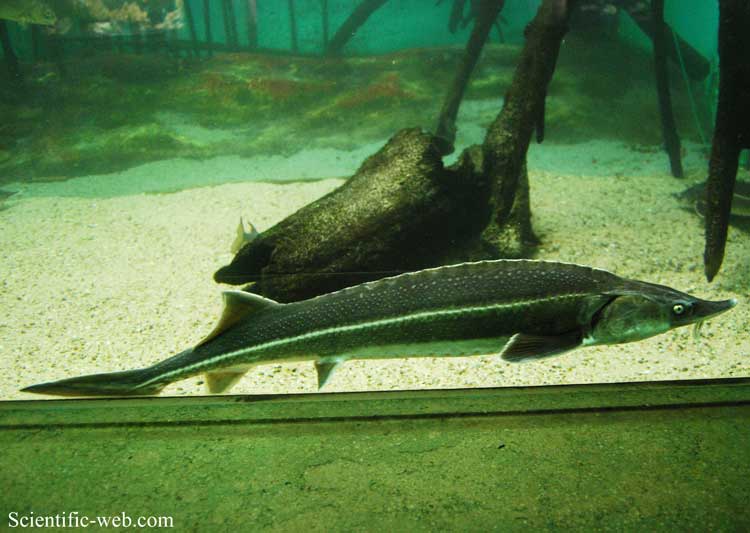
Acipenser ruthenus, Photo: Michael Lahanas
Superregnum : Eukaryota
Regnum: Animalia
Subregnum: Eumetazoa
Cladus: Bilateria
Cladus: Nephrozoa
Superphylum: Deuterostomia
Phylum: Chordata
Cladus: Craniata
Subphylum: Vertebrata
Infraphylum: Gnathostomata
Megaclassis: Osteichthyes
Superclassis/Classis: Actinopterygii
Classis/Subclassis: Actinopteri
Subclassis/Infraclassis: Chondrostei
Ordo: Acipenseriformes
Familia: Acipenseridae
Subfamilia: Acipenserinae
Genus: Acipenser
Species: Acipenser ruthenus
Name
Acipenser ruthenus Linnaeus, 1758
References
Linnaeus, C. 1758. Systema Naturae per regna tria naturæ, secundum classes, ordines, genera, species, cum characteribus, differentiis, synonymis, locis, Tomus I. Editio decima, reformata. Holmiæ: impensis direct. Laurentii Salvii. i–ii, 1–824 pp DOI: 10.5962/bhl.title.542: 237–238. Reference page.
Acipenser ruthenus – Taxon details on Integrated Taxonomic Information System (ITIS).
IUCN: Acipenser ruthenus (Vulnerable)
Acipenser ruthenus in the World Register of Marine Species
Vernacular names
azərbaycanca: Çökə
башҡортса: Уҡбалыҡ
беларуская (тарашкевіца): Сьцерлядзь
беларуская: Сцерлядзь
български: Чига
čeština: Jeseter malý
чӑвашла: Шĕке пулă
Deutsch: Sterlet
English: Sterlet
Esperanto: Sterledo
eesti: Sterlet
suomi: Sterletti
français: Sterlet
עברית: שטירל
magyar: Kecsege
Ido: Sterleto
italiano: Sterleto
lietuvių: Sterlė
кырык мары: Стерлӓк
Nederlands: Sterlet
norsk: Sterlett
polski: Sterlet, czeczuga
português: Acipenser ruthenus
română: Cegă
русский: Стерлядь
slovenčina: Jeseter malý
српски / srpski: Дугоноса кечига
svenska: Sterlett
Türkçe: Çuka baligi
татарча/tatarça: Чөгә
українська: Стерлядь
Tiếng Việt: Cá tầm nhỏ
中文: 小体鲟
The sterlet (Acipenser ruthenus) is a relatively small species of sturgeon from Eurasia native to large rivers that flow into the Black Sea, Azov Sea, and Caspian Sea, as well as rivers in Siberia as far east as Yenisei. Populations migrating between fresh and salt water (anadromous) have been extirpated.[1]
Due to overfishing (for its flesh, caviar, and isinglass), pollution, and dams, the sterlet has declined throughout its native range and is considered vulnerable by the IUCN.[1] Restocking projects are ongoing, and it has been introduced to some regions outside its native range, but the latter have generally not become self-sustaining.[1] Today, the majority of the international trade involves sterlets from aquaculture.[1]
Physical appearance
This section does not cite any sources. Please help improve this section by adding citations to reliable sources. Unsourced material may be challenged and removed. (January 2021) (Learn how and when to remove this template message)
The sterlet may reach 16 kg in weight and 100 to 125 cm in length, rarely exceeding a length of 90 cm.
It is quite variable in coloration, but usually has a yellowish ventral side.
It is distinguishable from other European species of sturgeons by the presence of a great number of whitish lateral scutes, fringed barbels, and an elongated and narrow snout, highly variable in length.
Feeding habits
The sterlet's main source of food is benthic organisms; they commonly feed on crustaceans, worms, and insect larvae.
On exhibition Subaqueous Vltava, Prague
Life history
Acipenser ruthenus3.jpg
The sterlet commonly reaches the age of 22 to 25 years. Males reach sexual maturity at 3–7 years old and females at 4–12 years old. Spawning occurs from the middle of April to the beginning of June. Females may lay from 15,000–44,000 eggs, at water temperatures preferably 12–17 °C (54–63 °F).
As pond fish
Sterlets require relatively large ponds with good water conditions, and may get entangled in plants such as blanketweed. They may require special food such as sterlet sticks, as they are unable to digest the vegetable proteins usually found in commercial fish foods.
As food
Sterlet with satsivi
In Russia, it is held in high esteem on account of its excellent flesh, contributing also to the best kinds of caviar and isinglass.
History
The sterlet also called Acipenser ruthenus, Linnaeus is the last of the five native sturgeon species inhabiting the Middle and Upper Danube River. Its population has dropped significantly, mainly due to the degradation of main habitats, spawning grounds and foraging grounds.[4]
References
Gessner, J.; Freyhof, J.; Kottelat, M. (2010). "Acipenser ruthenus". IUCN Red List of Threatened Species. 2010: e.T227A13039007. doi:10.2305/IUCN.UK.2010-1.RLTS.T227A13039007.en. Retrieved 19 November 2021.
Froese, R.; Pauly, D. (2017). "Acipenseridae". FishBase version (02/2017). Retrieved 18 May 2017.
"Acipenseridae" (PDF). Deeplyfish- fishes of the world. Retrieved 18 May 2017.
Kubala, Maroš; Farský, Martin; Pekárik, Ladislav (February 2019). "Migration patterns of sterlet ( Acipenser ruthenus, Linnaeus 1758) in the Middle Danube assessed by 1 year acoustic telemetry study". Journal of Applied Ichthyology. 35 (1): 54–60. doi:10.1111/jai.13859. ISSN 0175-8659.
Retrieved from "http://en.wikipedia.org/"
All text is available under the terms of the GNU Free Documentation License

